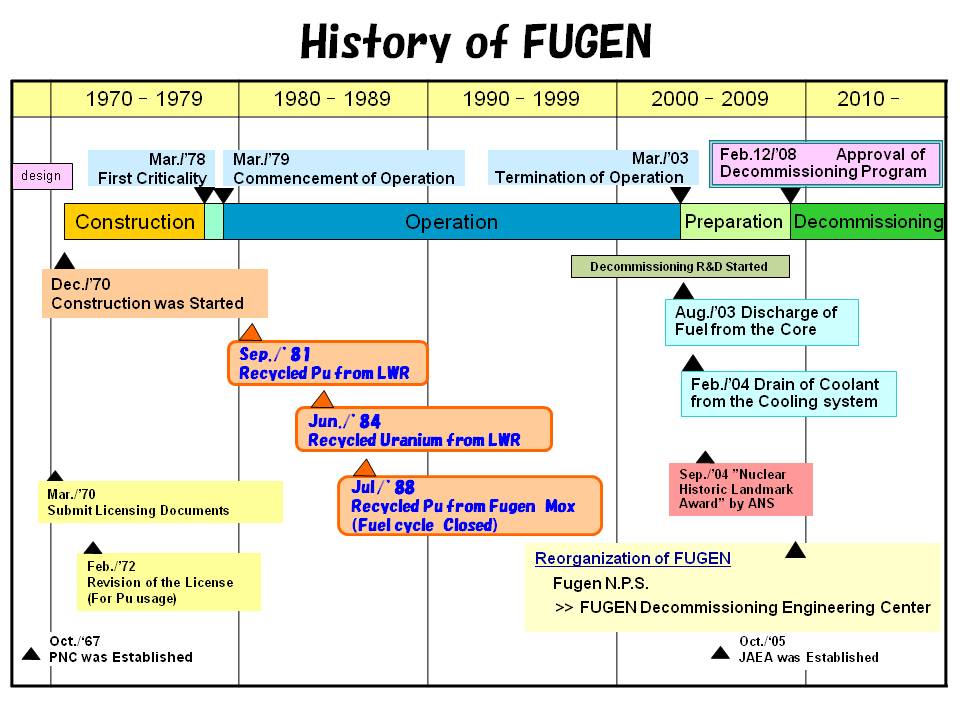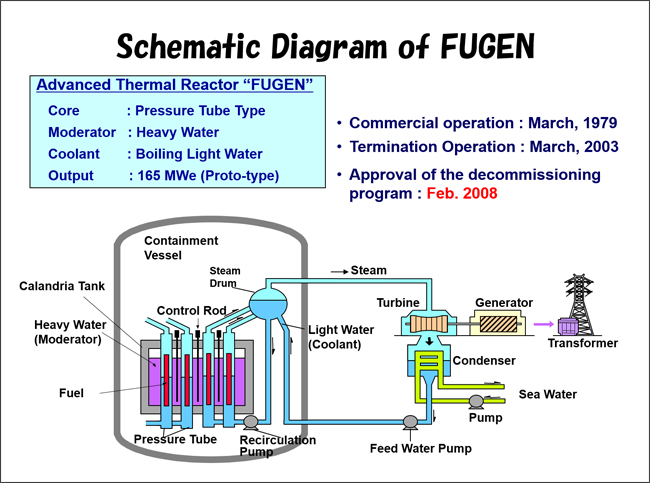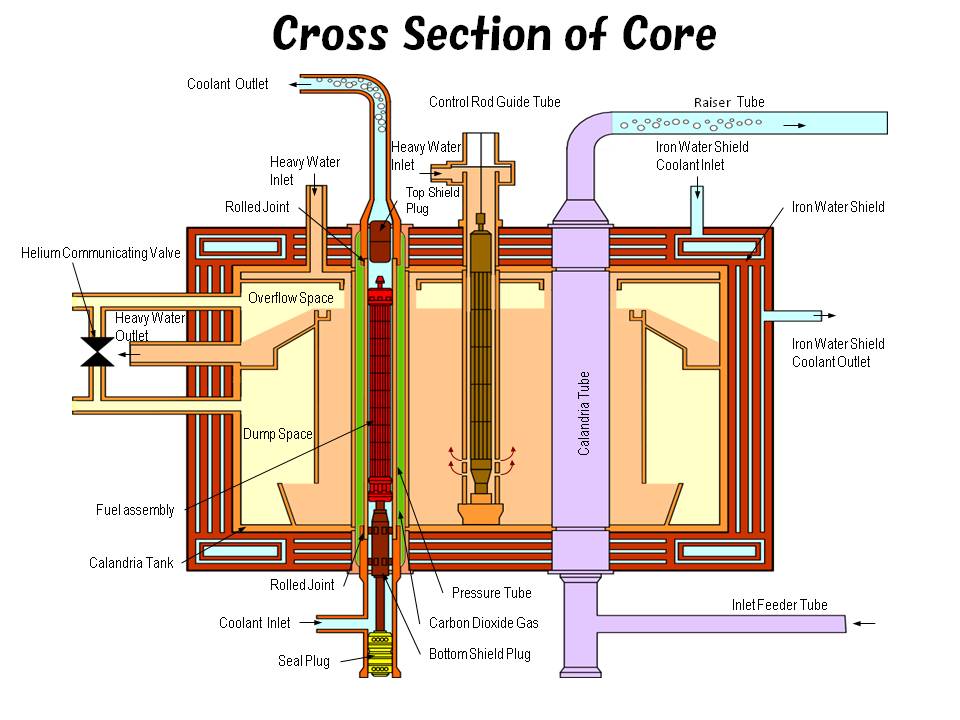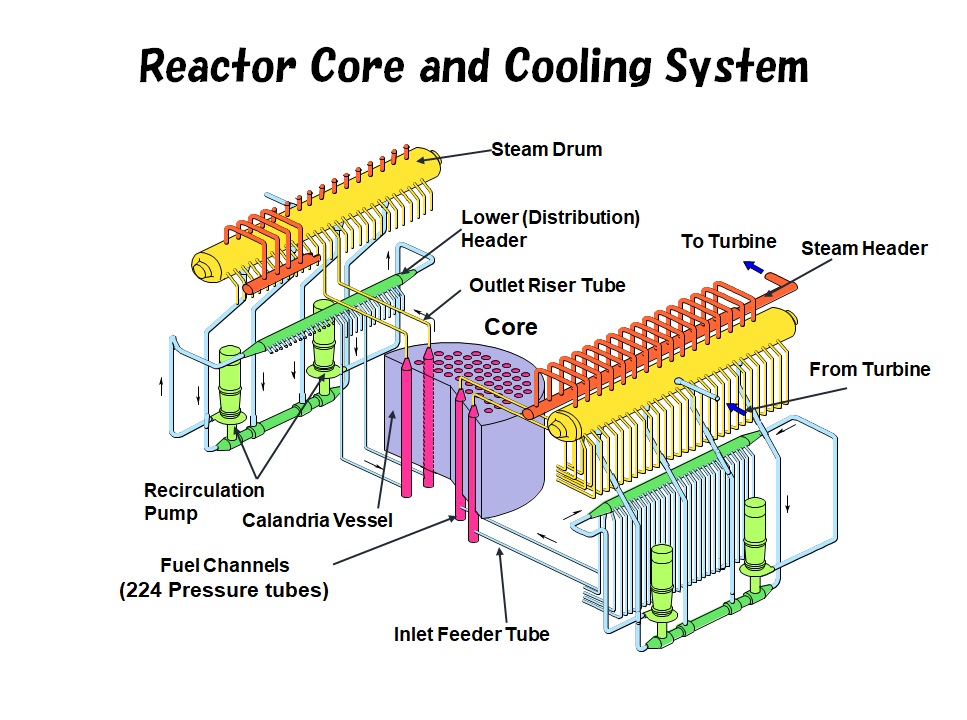History of Fugen
Start of FUGEN Project
On March 20, 1978, Fugen attained the first criticality loading 22 Mixed Oxide (MOX) fuel assemblies. This was the first achievement of the prototype Advanced Thermal Reactor (ATR), which was constructed colligating japan’s technology under a national project to ensure the energy security in Japan. The good news was reported to INFCE, which was founded by the proposal of U.S. President James Carter (who took office in 1977) to support both the peaceful utilization and non-proliferation of nuclear power. By referring to the thesis on ATR project, experts in the U.S. favorably evaluated Fugen as “a mirror of Japan s nuclear policy” which was based on peaceful utilization of nuclear power and plutonium recycling by Japan’ s self-development. ATR, which was initially born in the concept of utilizing natural uranium, shifted its role in the plutonium utilization strategy according to the energy circumstances with ATR’ s excellent core flexibility. With regard to the time of Fugen’s first criticality, ATR played a role as “plutonium burner.”
Pioneer of Plutonium Utilization
Since the first criticality, Fugen has been operating safely with MOX fuel for more than 25 years, demonstrating the technical feasibility of ATR as the first Japanese-made nuclear power plant by completing the nuclear fuel cycle. At the same time, Fugen has been playing the leading role in the nuclear fuel cycle and established the basis of plutonium utilization both in technological and political sense. Fugen has diametrically embodied Japan’s nuclear policy. The achievements of Fugen’s plutonium utilization contributed to the deep understanding of the peaceful utilization of plutonium in Japan, both nationally and internationally.
Plutonium Utilization in the Future
While the construction of the ATR demonstration plant delayed, plutonium utilization program of LWRs, one of the major option for the plutonium utilization, had advanced. The prospect that LWR could substitute for ATR in the utilization of plutonium led to the cancellation of the ATR project. Consequently, the operation of Fugen is scheduled to be terminated in the end of March 30, 2003, and the ATR project is also to be terminated in the end of September 2003. However, the visible and invisible achievements of Fugen are expected to be put to full use in the future for plutonium utilization in LWR, full MOX LWR, as well as FBR, which will play central role in the nuclear fuel cycle in Japan.
Mission of Fugen (ATR) Project
In May 1966, the Japan Atomic Energy Commission (JAEC) announced “Basic policies on Development of Power Reactors.” In this report, the commission drew up the basic plan regarding Japan’s in nuclear fuel policies in the future and development of power reactors, with the principle that “the nuclear fuel cycle shall be established in Japan for the purposes of realizing a stable supply and efficient use of nuclear fuel.” It also announced that research and development for the implementation of the plans should be selfdependent in order to improve the level of science and technology in Japan and to strengthen Japan's industrial foundation. While the ideas that the domestic fuel cycle should be based on the international nuclear fuel cycle, and technologies should be imported from overseas still existed, the statement declared it aimed at establishing self-dependent nuclear fuel cycle for the ultimate purposes of providing a stable supply of energy and ensuring energy security. Taking into consideration the flexible core characteristics of ATR and the possibility of using LWR technologies and experiences, the government decided to pursue development of the prototype reactor and constructed Fugen. ATR was expected to demonstrate, the efficient use of nuclear fuels, such as depleted uranium and plutonium in the early stages.
As mentioned above, Fugen took on two major missions as a national project. One was to demonstrate the full-scale utilization of plutonium as a forerunner of the national strategies to establish a self-dependent nuclear fuel cycle. The second mission was, as symbolized in the phrase “self-dependent development.” ’to improve technologies in large industries in Japan and to accelerate their maturation while making the most of the technologies of existing LWRs, and to enhance the overall industrial structure by strengthening the foundation of related industries, advancing development of infrastructure, and upgrading the level of technology. Additionally, the technological feasibility of ATR as a power plant designed and constructed by original conception was aimed to be proved.

History of Fugen’s Role
The Japanese government made the Long-term Plan for Research, Development and Utilization of Nuclear Energy to implement the nuclear policies concretely and systematically. The plan has been reviewed basically in five years and revised in response to both the progress of development and the energy situations in Japan and overseas. Although the basic policy of the plan to focus on plutonium recycling remains unaltered, the role of ATR has shifted under the nuclear fuel strategies.
This is due to the changes of surrounding circumstances of ATR such as the international situation of enriched uranium supply and demand, prospects of domestic technologies for emichment, maturation of LWR technologies, as well as the delay in the demonstration plant project for ATR. Correspondingly, ATR changed its role from plutonium supply reactor based on plutonium self-sustain*1 to plutonium burner*2 and finally to the reactor which complements the shift from plutonium utilization in LWRs to FBR.
For all Fugen’s design, construction and operation period were diametrically under such transitions, ATR’s flexible core characteristics made it possible to correspond to those circumstances without changing the reactor type or core structure.
*1:Method for maintaining operation only with the supply of natural uranium by using mixture of plutonium, which is produced by operation and natural uranium.
*2:Method for burning more plutonium than the self-sustained method by mixing plutonium recoveted from the reprocessing of spent LWR fuel, with natural uranium etc.
Fugen Plant Description and Features
Fugen was 165MWe nuclear power station (heavy water moderated, boiling light water cooled, pressure tube type).Its power output is the smallest among the nuclear power plants operating in Japan, but is the only plant to load MOX fuel. As the reactor uses heavy water*1 to moderate neutrons, its core struvture is different from that of LWR. But, other than that, it has a similar system to Boiling Water Reactor (BWR) in the respect that steam generated at the core directly turns the turbine for power generation.
The heavy water as moderator is kept in a calandria tank of approximately eight meters in diameter. In the tank, 224 pressure tubes, 12 centimeters in diameter, are installed vertically. One fuel assembly is set in each pressure tube, where light water flows as a coolant. The pressure tubes are surrounded by calandria tubes to make a double-tube structure so that the heavy water as moderator and light water as coolant are completely separated. Carbon dioxide gas flows in the space between the pressure tube and the calandria tube to mitigate the heat transfer from the fuel side to the heavy water side and to detect the leakage of coolant. Heavy water is cooled by circulation to maintain its fixed temperature (49 degrees centigrade at reactor entrance) in the core. Furthermore, boric acid is added to the heavy water to control the reactivity in the core. Helium is used as a cover gas for maintaining the purity of heavy water. Totally, there are 49 control rods, which are inserted from the reactor top into the heavy water via guide tubes installed in the calandria tank.
There are 224 fuel channels in the reactor cooling system, which consists of two independent reactor cooling loops with 112 channels for each. Coolant is supplied to the core through an inlet feeder tube that distributes coolant to each channel from a lower header of each loop. In the core, the cooling water is heated up to two phase flow, which enter a steam drum via an outlet riser tube. After water-steam separation in the steam drum, the steam goes directly to a turbine, and the heated water, along with feedwater, returns to the lower header through four down comers pressurized by two recirculation pumps.


